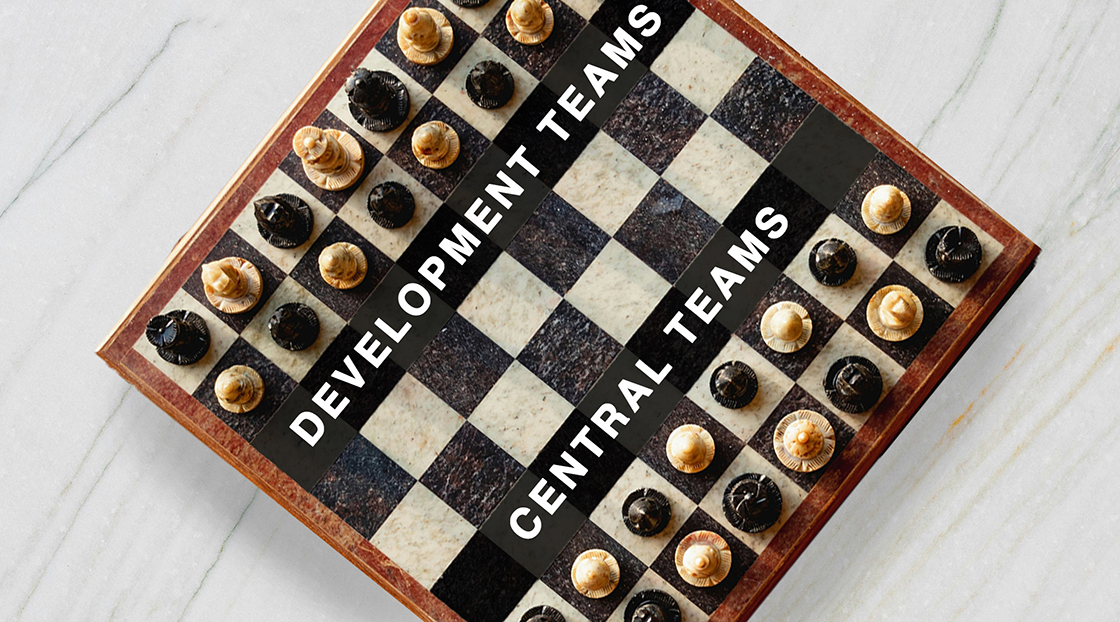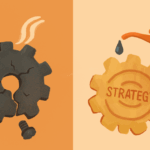In higher education, given the size and needs of the alumni and donor stakeholder base, marketing and communications positions are commonly situated in development, which is focused on engagement, donor relations and fundraising. Central marketing and communications positions have a broader focus that may include dean/leadership communications, admissions marketing, and revenue-producing programs such as executive education and media relations. The products they produce need to appeal to audience segments that often have no prior experience with the institution, unlike alumni who have lifelong relationships. Each group will ultimately be more successful when they nurture partnerships with each other in the following ways.
1. Map Out Shared Goals with a KPI Venn Diagram
To work effectively, both teams need a clear understanding of where their objectives overlap. Creating a Venn diagram of KPIs can help identify these intersections and ensure better alignment.
For example, school-wide social media efforts typically focus on engagement metrics such as reviews, likes and shares. In the alumni world, however, because the goal is increased engagement, social media usually sits in a larger digital engagement strategy to keep alumni connected across the various ways they engage. For us, digital engagement encompasses global and affinity-based alumni clubs and the online alumni directory.
2. Integrate Alumni and Donor Considerations into Crisis Communications
A well-prepared crisis communications plan should include a dedicated alumni and donor component. Unlike general audiences, these stakeholders have deeper, more personal ties to the institution, and the absence of communication during a crisis can have lasting repercussions.
Development marketing and communications professionals support front-facing staff who serve as a bridge between the institution and its alumni. Unlike external audiences, alumni expect direct and ongoing conversations with these representatives—pausing communication during a crisis can erode trust and engagement.
3. Tailor Institutional Messaging to Alumni Perspectives
Beyond crises, all school-wide communications plans should incorporate alumni and donor considerations. At Wharton Magazine, for example, we regularly evaluated what alumni wanted to hear, how much detail they needed, and the best ways to deliver that information.
Institutional news—whether related to leadership changes, new programs, or research—often needs to be framed differently for alumni audiences. With their insider perspective, alumni are looking for content that resonates with their ongoing connection to the institution. As our writing team expanded, I coached the team to remember we were not in the news business like many central communications shops were. The stories we told were rooted in the alumni and donor experience and represented the entire base.
4. Collaborate on Special Projects to Maximize Impact
Bringing teams together for well-defined projects with clear, shared objectives can strengthen partnerships and improve outcomes. Some successful collaborations include:
- Global events and gift announcements: working with central media relations colleagues to ensure effective promotion and messaging.
- Faculty and external speaker programs: coordinating with media relations to secure broader press coverage while maintaining alumni engagement.
- Alumni planning committees: These groups provide valuable insider perspectives and help amplify marketing and outreach efforts within their communities.
5. Repurpose Content and Assets across Both Teams
A strong partnership between marketing and alumni teams allows for more efficient use of content. Rather than working in silos, teams should be intentional about repurposing stories, digital assets, and promotional materials to serve both alumni engagement and institutional marketing goals.
For example, alumni-focused storytelling can be adapted for broader media coverage, while institutional achievements highlighted by central marketing can be reframed to resonate with alumni. This reciprocal approach ensures that content works in multiple contexts and reinforces shared objectives.
When these collaboration strategies are in place, they encourage the desired behaviors: alumni attending reunions, engaging with students, joining clubs, and making annual gifts, while central marketing teams achieve greater media exposure, website traffic, and leadership visibility.
Considering these steps will help strengthen trust between the shops and foster stronger partnerships. Strategic collaboration benefits both teams and the institution—enhancing engagement, strengthening donor relations and amplifying institutional messaging.







